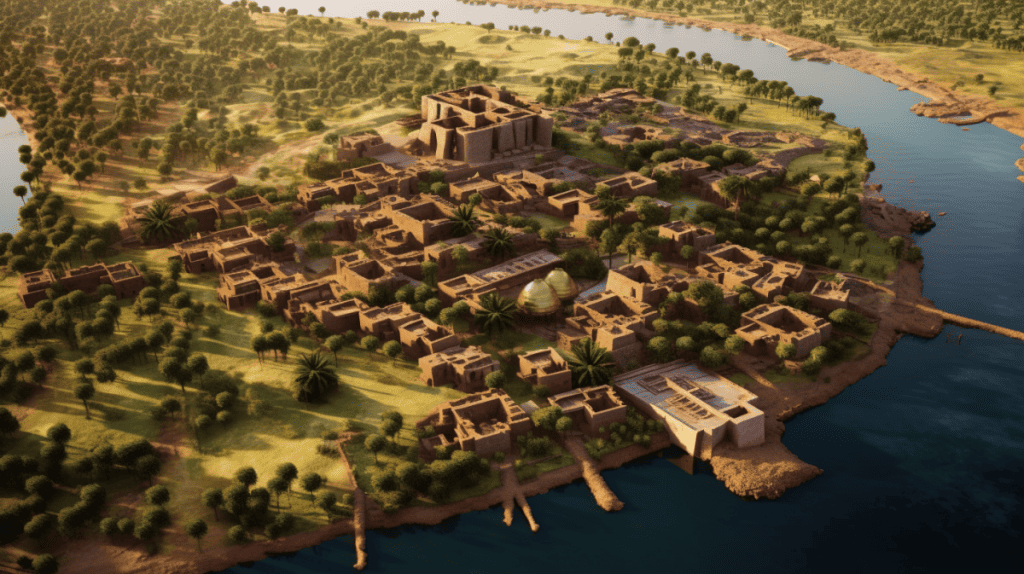Meroe, in today’s Sudan, was the heart of the Kingdom of Kush from 800 BCE to 350 CE. As the capital, it boomed from ironwork and trade. With unique pyramids and deep cultural imprints, Meroe showcases Africa’s age-old civilisations.
Facts about Meroe
In the heart of the historic Kingdom of Kush, presently recognized as Sudan, there once stood a bustling centre named Napata. For a time, Napata held significant prominence. However, following disturbances around 590 BCE, the focus shifted to Meroe, which served as the capital from approximately 1069 BCE to 350 CE. Meroe’s location was not a mere coincidence in the desert; it was strategically positioned at the crossroads of crucial trade routes, leading to its prosperity for numerous centuries. It has even been honoured by UNESCO as a World Heritage Site.

Meroe indeed presents a puzzle. The Meroitic script remains undeciphered, leaving us with some blurred specifics. But what we are certain about is the city’s immense wealth, so much so that Cambyses II of the Persian Achaemenid Empire once contemplated acquiring a share of its riches. Yet, the challenging desert terrain thwarted his ambitions (or perhaps he simply refrained from the endeavour – accounts differ). Regardless, the existence of such tales regarding this expedition underscores Meroe’s notable reputation.
Fun Fact
Meroe was often referred to as the Island of Meroe due to the river courses encircling it. For those acquainted with biblical texts, it might be recognized as Aethiopia from Genesis (10:6). Unfortunately, in spite of its illustrious history and significance, the city faced its downfall around 330 CE when a king from Aksum targeted it.
Civilisation
In its prime, this locale was the epicentre for iron production. Imagine it being the ancient counterpart to what Birmingham represents today – a perspective shared by Archibald Sayce. While there’s some contention about its actual magnitude, let’s be real: if you’re trading iron with prominent nations like India and China, you’re certainly on the right track.

While much attention is given to their prowess in iron, what genuinely intrigues me is their mastery over pottery. They didn’t merely produce ordinary pots and pans. Instead, they created beautifully detailed wares, echoing profound cultural significance, particularly in funeral rituals.
When it comes to commerce, aside from their renowned iron and pottery, Meroë also excelled in textiles, jewellery, and surprisingly, “exotic” animals. Their cotton textiles were nothing short of masterpieces, reaching their zenith around 400 BC. Additionally, the term “Nubia” is believed to have originated from the Egyptian word for gold, a resource they possessed in ample amounts.

Intriguingly, in Meroë, the measure of one’s influence wasn’t the expanse of land they owned, but rather the number of people under their dominion. This suggests a society that valued human capital and skills over territorial ownership. They even had an innovative water-management device called the Sakia, which greatly enhanced their agricultural capabilities.
Picture this for a moment: the inhabitants had constructed what can be described as a colossal “rainwater harvesting system.” Imagine a reservoir with a staggering diameter of 820 feet and a depth of 32 feet! But it wasn’t merely functional; aesthetics mattered too. They adorned its sides with impressive animal motifs. Astoundingly, this enormous reservoir had the capacity to cater to the water needs of a city housing 300,000 residents!
At the pinnacle of their power, the leaders of Meroë dominated the Nile Valley, commanding a remarkable stretch of 620 miles. At the helm was the King of Meroë, who largely held exclusive control over decisions, with possible exceptions for the Queen Mother or Candace, although her exact role remains somewhat enigmatic. Supporting the king was an entourage comprised of treasurers, scribes, and various other officials.
The Candaces, or Queens of Meroë, deserve special mention.
Enter Ergamenes (or Arkamani I). He introduced groundbreaking changes. Breaking away from traditional Napata burial practices influenced by the Egyptians, he pioneered the trend of conducting burials outside Meroë. This significant shift around 285 BCE led to a noticeable decline in the distinctive Egyptian-inspired styles and inscriptions found in relics.

Here’s where the narrative takes a tantalizing twist: the well-known gods of ancient Egypt, such as Isis and Amon-Ra, underwent a transformation. They were seamlessly integrated into the worship of the distinct Nubian deities, like Apedemak, the formidable lion god. And what adds an even more fascinating layer? Queens didn’t just play a ceremonial role; they co-ruled with kings. These formidable women were termed ‘Kentake’, though many might recognize them by the moniker ‘Candace’, a title akin to ‘Queen Regent’ or ‘Royal Mother.’ Remarkably, between 170 BCE and 314 CE, there were no fewer than seven of these influential queens.
Let’s shine a light on two standout queens: Candace Amanishakheto and Candace Amanitore. In depictions, they’re illustrated as dominant figures, almost making their adversaries seem insignificant in comparison. It’s a visual testament to the message: “Crossing a Meroitic Queen is a perilous idea!”
Diving into legends, there’s this enthralling story concerning Alexander the Great receiving a sobering lesson from a Candace of Meroe around 332 BCE. This audacious queen had her military formation so impeccably organized that Alexander allegedly decided, “This isn’t worth the trouble.” Even if this account borders on folklore, it vividly captures the aura of these mighty queens.

But the saga intensifies. Transition to a climactic encounter between the might of Meroe and Augustus Caesar during the Meroitic War (27-22 BCE). The spotlight undeniably shines on Candace Amanirenas. She not only showcased stellar leadership in directing her forces, but she also successfully brokered a peace agreement with Augustus. And the most intriguing part? The terms she negotiated leaned more towards celebrating Meroe’s triumph rather than extolling Rome.
Meroe Pyramids
The Meroe Pyramids of Sudan, crafted by the Kingdom of Kush, stand as relics of an ancient civilization. Unlike Egyptian pyramids, these structures, dating back 4,600 years, reflect the distinctive architectural and cultural identity of the region.
The ancient city of Meroë boasts a captivating spectacle! These aren’t the quintessential Egyptian pyramids we often visualize; they bear a distinctive Nubian touch, epitomizing the latter era of the Kingdom of Kush, which extended from the 3rd century BCE to the 4th century CE. Esteemed members of the Kushite realm, encompassing royalty, their kin, and prominent officials, found their final resting place amidst these structures.

Envision this: a sprawling landscape encompassing three immense cemeteries, housing more than a thousand burial sites! What’s even more fascinating? Out of these, approximately 147 were identified as pyramid structures. The southern cemetery particularly stands out, being home to an impressive 82 of these pyramids. Interestingly enough, the majority of these weren’t even designated for royalty.
Shift your attention to 8th September 2020. Nature had its own plans, posing a challenge to these grand edifices. For the first time, these iconic structures faced the peril of flooding.
Southern Cemetery Deep Dive
In its formative years, around 270 BCE and thereafter, the southern cemetery was the favoured burial site for the elite of the Kushite kingdom. With an estimated 220 burial sites, it showcased about 90 discernible structures. Intriguingly, no fewer than 24 of these took on the distinctive form of pyramids. However, there’s a melancholic twist: a significant number of tombs in this vicinity have suffered desecration at the hands of treasure seekers throughout history.
Northern Cemetery Snapshot
Shifting focus from the southern cemetery, the northern one subsequently became the prime location for royal interments. Home to 41 pyramids, it served as the resting place for approximately 30 kings, eight sovereign queens, and possibly an additional three individuals, presumed to be crown princes.
The Meroitic Language
Let’s delve into the linguistic nuances of ancient Meroë, shall we? The people of Meroë communicated in a language called Meroitic. This language was in vogue from roughly 300 BC and waned by about 400 AD. The manner in which they documented this language is quite fascinating. They employed two distinct scripts: Firstly, the Meroitic Cursive, which was akin to their daily script for routine documentation. Secondly, the Meroitic Hieroglyphic, was reserved for more ceremonial or ornate purposes, like inscriptions on stone or royal edicts.
The challenge lies in deciphering Meroitic, primarily due to the scarcity of reference materials. However, an ancient engraving, dated between 180-170 BC on Queen Shanakdakhete’s temple, offers a peek into this language. An intriguing tidbit: When written in Meroitic Cursive, the script is read from right to left, reminiscent of certain Semitic scripts.
By the 3rd century BC, there was an innovative wave in the air, prompting the development of a new Meroitic script. This script, comprising twenty-three letters, drew inspiration from Egyptian hieroglyphs and was primarily tailored to encapsulate the unique essence of the Meroitic language in the Kingdom of Kush. This new system of writing made its entrance during the Napatan Period, roughly spanning 700-300 BC.
Yet, the paramount question that still lingers is: where does the Meroitic language sit in the grand tapestry of linguistic families? Some scholars posit that it shares a kinship with the Egyptian language, falling under the Afro-Asiatic umbrella, given its phonetic and structural similarities. Conversely, there are those who align it more closely with the Nobiin language, nestled within the Eastern Sudanic branch of the Nilo-Saharan family. The conclusive verdict? It remains an ongoing debate in linguistic circles!
Decline of Meroe
Time to shed some light on Meroe’s contemporary standing! Nowadays, if you find yourself journeying through Sudan, Meroe undoubtedly tops the list of archaeological destinations. Picture yourself meandering amidst the skeletal remains of pyramids, opulent palaces, and grand administrative buildings, sensing the palpable history of a once-thriving metropolis. While there are murmurs surrounding the enigmatic disappearance of Meroe’s populace, let’s set the record straight: a towering victory stele graces the site. Many attribute this monument to King Ezana, a Christian ruler from Aksum. This significant marker alludes to the Aksumites seizing control of the city circa 330 CE.

It’s truly a poignant chapter in history – this takeover marked the curtain call for the Meroitic language, extinguishing its written and verbal legacies. As if this cultural blow wasn’t grievous enough, Meroe also found itself grappling with nature’s fury. Fueled by its thriving iron industry, the region grappled with rampant deforestation. Further exacerbating its plight, intensive cattle grazing and agricultural pursuits drained the vitality from the soil. In no time, Meroe began its precipitous descent. By the dawn of the 5th century CE, the once-vibrant city had metamorphosed into the stuff of myths and legends.
Related Posts
Sources
- Mark, Joshua J. “Meroe.” World History Encyclopedia. Accessed [22.08.23]. https://www.worldhistory.org/Meroe/.
- Wikipedia contributors. “Meroë.” Wikipedia. Accessed [22.08.23]. https://en.wikipedia.org/wiki/Mero%C3%AB.
- “Island of Meroe.” UNESCO World Heritage Centre. Accessed [22.08.23]. https://whc.unesco.org/en/list/1336/.






